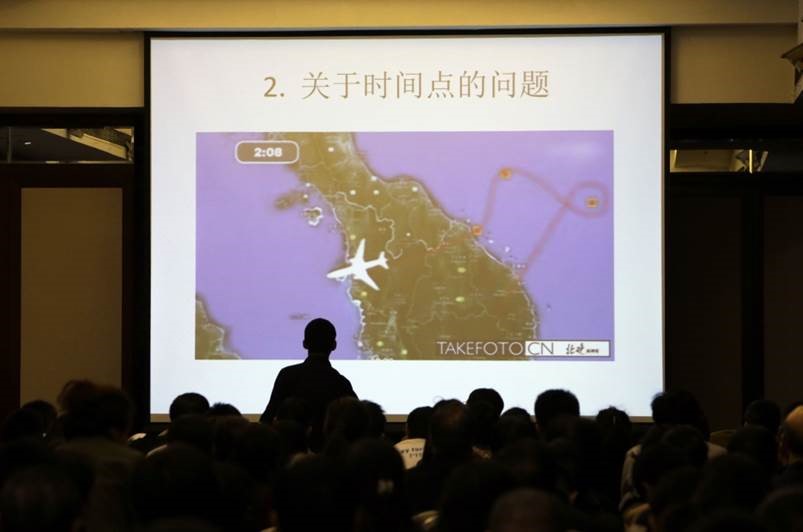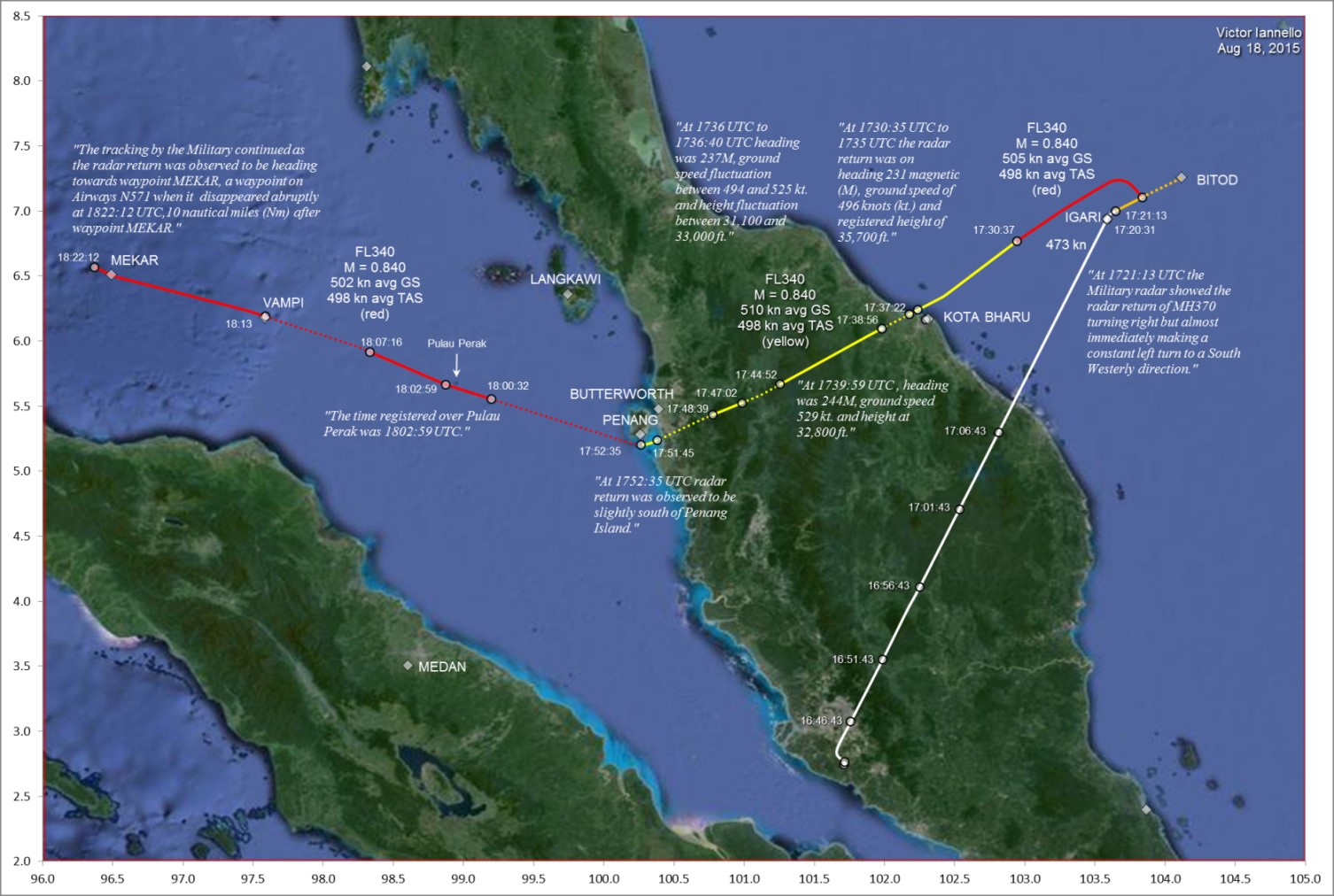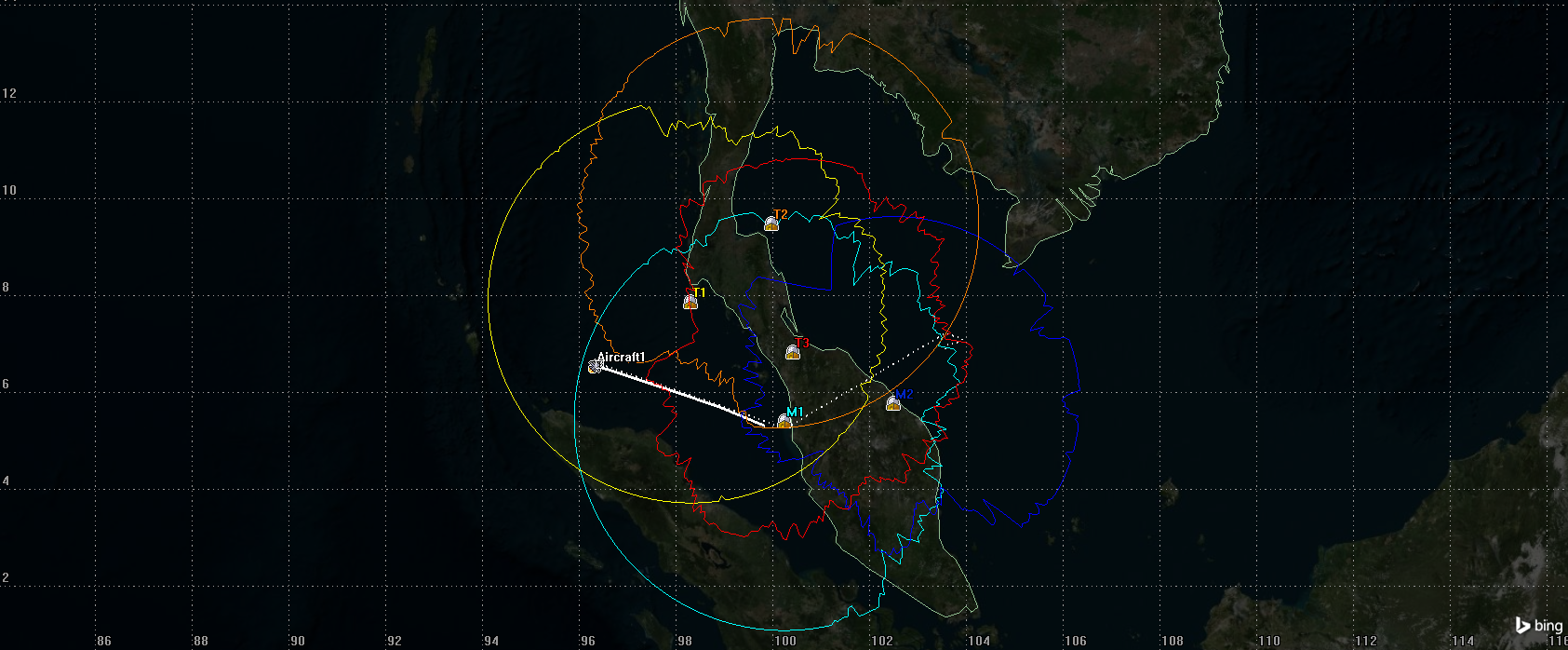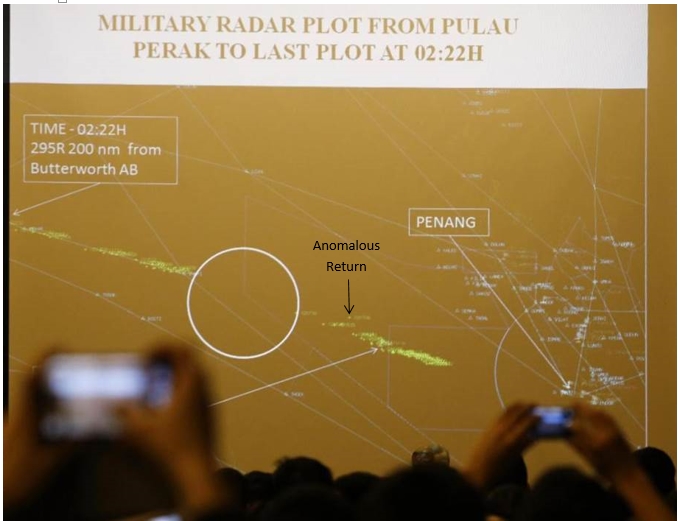Questions about the Radar Data for MH370
by Victor Iannello, ScD
September 24, 2015
A PDF version of this report may be downloaded by clicking here or here (540 kB).
Notice: The views expressed here belong solely to Victor Iannello and do not necessarily represent the views of the Independent Group (IG), or any other group or individual.
Introduction
In a recent paper [1], we analyzed the position and time data derived from the publicly-available radar data for MH370, and made the following observations:
- After the turn back towards the Malay Peninsula, the flight path recorded by civilian primary surveillance radar (PSR), civilian secondary surveillance radar (SSR), and military radar are consistent with a flight at a Mach number (M) equal to 0.84 at a cruising level of FL340.
- If the aircraft did fly at a steady M = 0.84, then the timestamps for some of the PSR contained in the Factual Information (FI) [2] are offset by about 35 seconds.
- After the left turn at around 17:23:38 UTC, the aircraft might have descended from FL350 to FL340 and accelerated from a ground speed of 473 kn to a ground speed of greater than 500 kn.
- In the FI [2], the PSR data between 17:47:02 and 17:52:35 UTC are attributed to the radar site at Kota Bharu, but more likely were collected by another radar site. The PSR data between 17:30:37 and 17:44:52 are correctly attributed to Kota Bharu.
- In the FI [2], it is stated that Indonesian military radar recorded MH370 as it traveled toward IGARI but not as it traveled back over Malaysia. One explanation is that Indonesian radar site was powered down after midnight, local time.
- The sharp turn to the left at around 17:23:38 UTC is unexplained, and could be due to either an inaccurate graphical portrayal of the radar track, or crossing radar tracks from two aircraft.
- The curve in the radar path close to Kota Bharu can be explained by “slant range” due to high altitudes and close distances.
- Fuel consumption models which assume that MH370 flew near Long Range Cruise (LRC) speeds and at cruising altitudes between 17:07 and 18:22 are likely accurate.
The estimated path and speeds for MH370 from takeoff to the last radar point [1] is shown in Figure 1.
Bob Hall [3] used the software package STK to calculate the radar range for various military radar installations in Thailand and Malaysia that may have seen MH370. The range calculations were solely based on the line-of-sight between the target aircraft and the radar head, including any obstruction caused by terrain features such as hills and mountains. The calculations were performed for a geometric altitude of 37,000 ft, which corresponds to a pressure altitude of about 35,000 ft (i.e. FL350) over Malaysia at the time of the disappearance. The results are shown in Figure 2. (The path shown for MH370 in Figure 2 is not exactly correct because at the time the plot was generated in October 2014, the details of MH370’s path as derived from the radar data were not known.)
Based on the work performed in [1] and [3], we have developed a list of questions related to the radar data that would help the public to better understand this incident. We believe that the answers to many or all of these questions are known to the Malaysian investigators, and we see no valid reason for not making this knowledge available to the public.
Figure 1. Estimated path and speeds for MH370 from takeoff to the last radar point [1].
Figure 2. Range of military radar sites for an aircraft at 37,000 ft [3].
(A higher-resolution, bitmap version of Figure 2,
without the annotation at left.)
Questions
- Was the turn to the left after IGARI captured by Malaysian military radar? It was in range of the radar head at Bukit Puteri, Jirtih, but near the range limits of Western Hill, Penang Island.
- Was the turn to the left after IGARI captured by Thai military radar? It was near the range limits of the radar heads at Ko Samui Island and Khok Muang.
- The turn to the left after IGARI was depicted in two ways. At the meeting with the next-of-kin (NOK) on Mar 21, 2014, at the Lido Hotel in Beijing, it was depicted as a looping, 270-degree turn to the right, as shown in Figure 3. By contrast, in Figure 2 of the ATSB report [4] from June 26, 2014, the turn is depicted as a sharp turn to the left. What is the reason for this discrepancy of the depictions of the turn after IGARI? Which of these depictions is correct?

Figure 3. Flight path shown to the NOK on March 21, 2014, at the Lido Hotel in Beijing.
- The depiction of the turn after IGARI as a sharp turn to the left seems to be beyond the performance limitations of a B777. Was the turn accurately depicted in Figure 2 of the ATSB report [4] from June 26, 2014?
- Is it possible that the sharp turn to the left after IGARI is actually the crossing of the radar returns from two aircraft?
- What specifically led investigators to conclude that the unidentified aircraft that crossed the Malay Peninsula and proceeded up the Malacca Strait was indeed MH370?
- On March 21, 2014, military radar data from an unidentified aircraft (assumed to be MH370)) above the Malacca Strait was presented to the NOK at the Lido Hotel in Beijing, and shown in Figure 4 . Were these radar returns captured by the radar installation at Western Hill, Penang Island?
Figure 4. Radar data shown to the NOK on March 21, 2014, at the Lido Hotel in Beijing.
- At the time of disappearance of the unidentified aircraft from military radar at 18:22 UTC, the aircraft was within range of the Thai military radar head at Phuket. Did this radar station also capture this unidentified aircraft? Is so, what was the path after 18:22?
- In Figure 1.1F of the FI [2], the radar returns between 17:30:37 and 17:52:35 are attributed to the primary surveillance radar (PSR) returns as captured at Kota Bharu. The unidentified aircraft was supposedly captured by Kota Bharu radar until it reached just south of Penang, which exceeds the 60 nm range of the radar head at Kota Bharu. How is it possible that the radar returns are correctly attributed to Kota Bharu for the entire interval between 17:30:37 and 17:52:35? Is it possible that the radar returns after 17:44:52 were captured by another installation such as the terminal approach radar at Butterworth?
- What was the cause of the disappearance of radar returns from the unidentified aircraft after 17:44:52, 17:48:39, 17:52:35, and 18:07:16? Some believe this indicates the unidentified aircraft was descending at these times, but this interpretation is not consistent with calculations [1] that indicate that the unidentified aircraft flew at nearly constant 498 KTAS, corresponding to M=0.84 at FL340.
- Is it possible that the disappearance of the unidentified aircraft from radar was due to electronic countermeasures such as jamming and deception?
- In Figure 1.1F of the FI [2], there is a point labeled as P1706 that is located near Kuala Lumpur International Airport (KLIA), but has a timestamp which appears to be 17:28:41, which should place the target much closer to the left turn after IGARI. What is the reason for this anomalous capture?
- As described in [1], there seems to be a time shift of about 35 sec from some of the radar returns attributed to the PSR head at Kota Bharu. Are all of the timestamps from Figure 1.1F of the FI [2] referenced to a single clock, or at least from synchronized clocks?
- In Figure 4, there is an anomalous return (as labelled in black by VI) at 02:07:06 MYT (18:07:06 UTC) that is north of the other returns and is not explained. Was this target possibly another aircraft?
- The radar images presented to the public to date show no other traffic. What other traffic was in the vicinity of MH370 and the unidentified aircraft?
References
[1] Victor Iannello, “Some Observations on the Radar Data for MH370”, August 18, 2015. Also available here.
[2] Malaysian ICAO Annex 13 Safety Investigation Team for MH370, “Factual Information, Safety Investigation for MH370”, March 8, 2015; updated April 15, 2015.
[3] Bob Hall, private email to the Independent Group, October 16, 2014; used with permission.
[4] Australian Transport Safety Bureau (ATSB), “MH370 – Definition of Underwater Search Areas”, June 26, 2014.



